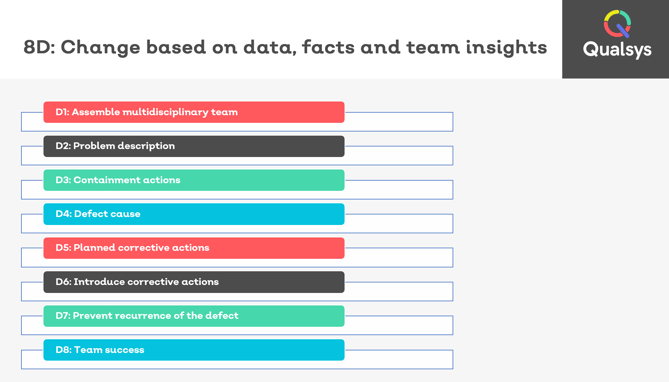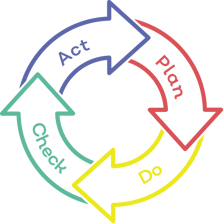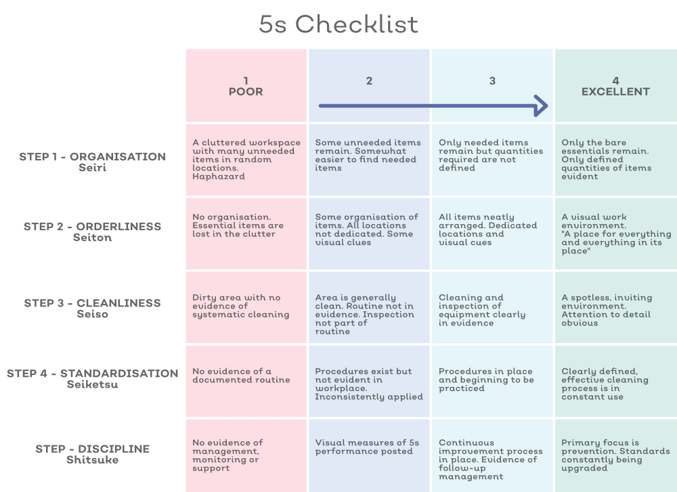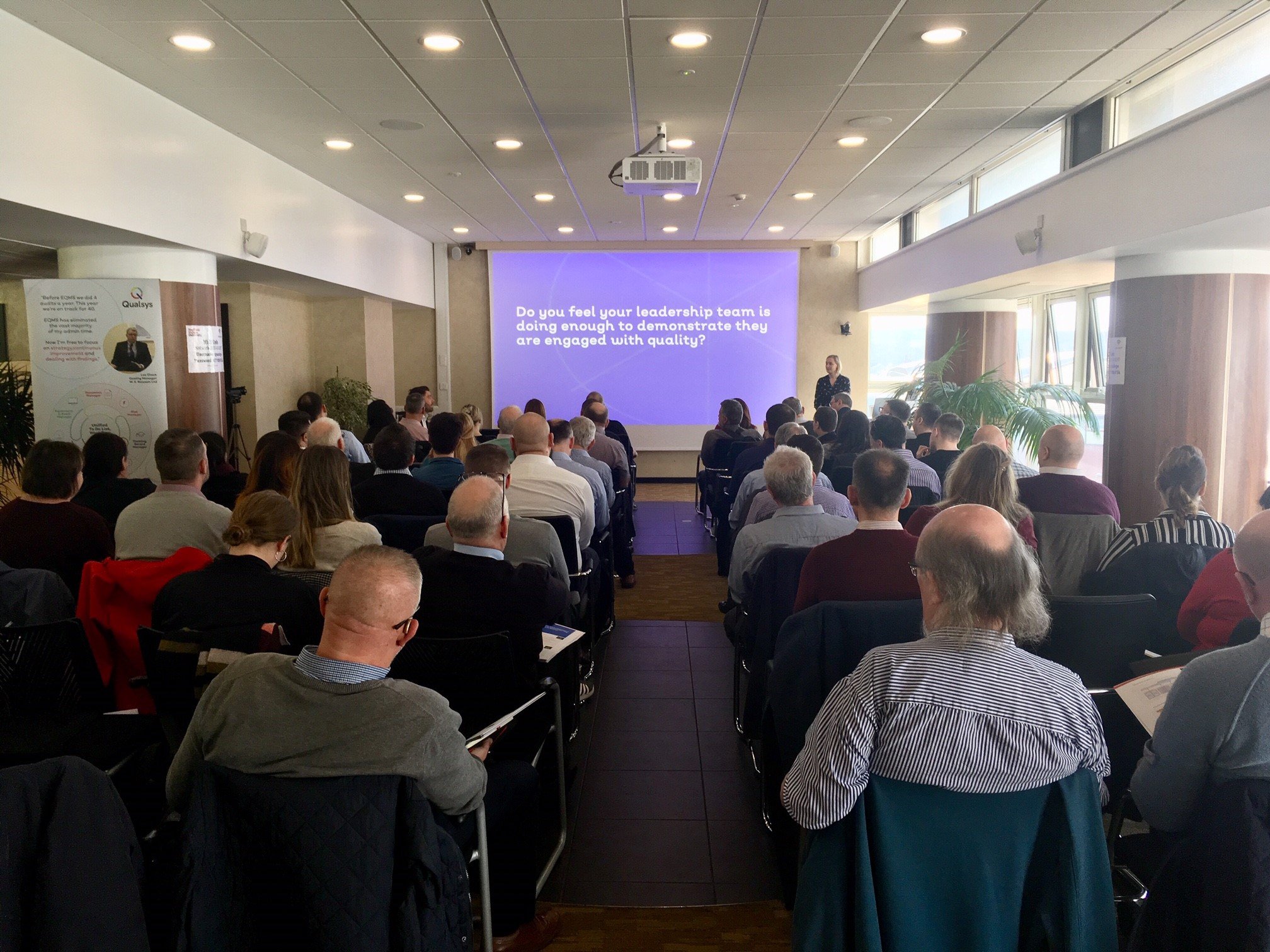Want to contribute to this article?
The quality management world is its own special place with a unique language. If you've ever felt lost in the jargon, you aren't alone! That's why we've pulled together this glossary.
Here you'll find all the terms Qualsys and our customers use on a regular basis, along with their definitions.
To know your RADAR from your RAM or learn more about the 5Ss, take a look below.

A
ANOVA
Analysis of variance is a collection of statistical models and their associated estimation procedures used to analyse the differences among group means in a sample.
APQP
Advanced product quality planning is a framework of procedures and techniques used to develop products in industry, particularly the automotive industry.
AQL
The acceptable quality level is the worst tolerable process average (mean) in percentage or ratio that is still considered acceptable; that is, at an acceptable quality level.
B
BPM
Business process mapping (BPM) refers to activities involved in defining what a business entity does, who is responsible, to what standard a business process should be completed, and how the success of a business process can be determined.
C
CQI
Continuous quality improvement is a management philosophy used by organisations to better their processes.
CTX
Critical to X (CTX) comprises various types, dependent on your focus. It may be CTQ (Critical to Quality), CTD (Critical to Delivery) or CTP (Critical to Process).
More information about different types of Critical to X here.
CAPA
Corrective and preventive action (also called corrective action/preventive action or simply corrective action) consists of improvements to an organisation's processes taken to eliminate causes of non-conformity or other undesirable situations.
CRISP
Catch-reflect-improve-scrutinise-pass (CRISP) is used frequently in policy development. Based on the plan-do-check-act cycle, designed to enable an organisation to deploy its vision, missions, goals, objectives, targets and means more effectively.
D
8D
8D stands for the 8 disciplines of problem solving. They represent 8 steps to take to solve difficult, recurring or critical problems. More on 8D

DMAIC
DMAIC ("Duh-MAY-ick") is a structured problem-solving methodology widely used in business. The letters are an acronym for the five phases of Six Sigma improvement: Define-Measure-Analyse-Improve-Control. Here's how to use DMAIC to solve complex problems.
DMEDI
A conceptual, creative approach to the design of new processes used in Six Sigma process design projects. DMEDI stands for Define, Measure, Explore, Develop and Implement.
E
EQMS
Enterprise, or electronic, quality management system. More here

F
FMEA
Failure mode and effects analysis is a step-by-step approach for identifying all possible failures in a design, a manufacturing or assembly process, or a product or service. It is a common process analysis tool.
- Failure modes means the ways, or modes, in which something might fail. Failures are any errors or defects, especially ones that affect the customer, and can be potential or actual.
- Effects analysis refers to studying the consequences of those failures.
G
GxP
Good ... practice, with the 'x' interchangeable for a range of industry practices, from GDocP (good document practice) to GLP (good laboratory practice) and GMP (good manufacturing practice). More here
H
HACCP
A farm-to-table food quality management system, standing for hazard analysis and critical control point. A string of critical control points are mapped onto the food manufacture process to maintain quality throughout. Download our HACCP toolkit
I
ISMS
An information security management system is a set of policies and procedures for systematically managing your data. The goal is to minimise risk and ensure business continuity by proactively limiting the impact of a security breach. More on developing your ISMS here.
J
JIT
A lean and optimised 'just in time' manufacturing process where little or no inventory is accumulated. Less commonly, can refer to 'just in time' training where training is limited only to when it is absolutely needed.
K
KPI
Key performance indicator, a statistical measure of effectiveness. A handful of clear, trackable KPIs is crucial for effective quality management. Read our 5 quality KPIs you should be tracking.
L
LTPD
Lot tolerance percentage defective, the poorest acceptable quality within an individual lot. Forms the basis of some manufacturing inspection systems.
M
MSA
Measurement system analysis (MSA) is defined as an experimental and mathematical method of determining the amount of variation that exists within a measurement process. Variation in the measurement process can directly contribute to your overall process variability. MSA is used to certify the measurement system for use by evaluating the system’s accuracy, precision and stability.
N
NCR
Non-conformance, an observed fault or deviation within the output of a process, procedure or wider QMS noted in an audit. Commonly tackled with 8D. Read our 8D problem-solving approach for non-conformances.
O
OEE
Overall equipment effectiveness, the measure of how well a physical asset performs relative to its designed capacity. Read our 7 questions to ask when managing business equipment.
P
PDCA
Plan-do-check-act is an iterative four-step management method used in business for the control and continuous improvement of processes and products. It is also known as the Deming cycle, the Shewhart cycle, the control cycle, or plan–do–study–act (PDSA).

Q
QCs
A group of employees who meet regularly to consider ways of resolving problems and improving production in their organisation.
R
RADAR
Results, approach, deployment, assessment and review logic is a dynamic assessment framework and powerful management tool that provides a structured approach to questioning the performance of an organisation.
RAM
Reliability, availability, and maintainability analysis is a well-known method of estimating the production availability of a system by assessing failure modes, frequencies and consequences, all the while paying attention to the effect on production.
RCA
Root cause analysis
ROQ
Return on investment in quality, or "return on quality". It enables quality improvement expenditures to be evaluated as investments, on an equal footing with other financial investments. The approach is based on the following philosophy of quality improvement:
1. Quality is an investment2. Quality efforts must be financially accountable
3. It is possible to spend too much on quality
4. Not all quality expenditures are equally valid
S
5S
5S is a system for organising spaces so work can be performed efficiently, effectively, and safely. It stands for sort, set in order, shine, standardise and sustain.

SIPOC
Suppliers, Inputs, Process, Outputs and Customers is a process snapshot that captures information critical to a project. More on SIPOC here.
SPC
Statistical process control is an industry standard methodology for measuring and controlling quality during the manufacturing process.
T
TOPS
Ford Motor Company developed this problem solving methodology, then known as Team Oriented Problem Solving (TOPS), in the 1980s. The early usage of 8D proved so effective that it was adopted by Ford as the primary method of documenting problem solving efforts, and the company continues to use 8D today.
TQC
Total Quality Control is the organised Kaizen activities involving everyone in the company in totally integrated effort toward improving performance at every level. This improved performance is directed toward satisfying cross-functional goals like quality, cost, scheduling, manpower, development, and new product development. It is assumed that these activities ultimately lead to increased customer satisfaction.
TQM
Total quality management is the process of transformation by which all parts of the organisation have a focus on quality, with the ultimate objective of customer satisfaction and delight. Some people argue that the term TQM has fallen out of use, with directors and managers regarding it as a fallen star and a jaded concept. They moved on to what are perceived as newer concepts like Six Sigma and Lean mapping. There is little doubt that in managed companies and industries the issue of improvement in the quality of products and services remains top priority.
V
VSM
Value stream mapping is a lean management method for analysing the current state and designing a future state for the series of events that take a product or service from its beginning to the customer. The primary focus is to increase leanness and decrease wastage compared to the current stream map.
VoC
Voice of the customer is a term used in business and information technology to describe the in-depth process of capturing customers' expectations, preferences and aversions.








Share your thoughts on this article